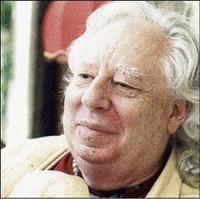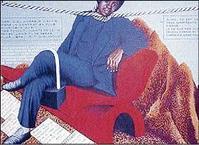
Portrait of Edward Lucie-Smith.
Cheri Samba Contributed photos
Edward Lucie-Smith was born in Kingston, Jamaica. He is a poet, photographer and art historian who has risen to great heights internationally: He has written over 100 books, curated numerous exhibitions and lectured in museums and galleries around the world. His books have been translated into many languages and are used as textbooks at prestigious universities and schools.
Notably, he produced the book Albert Huie: Father of Jamaican Painting, in 2000, and a book on the Jamaican artist JudyAnn MacMillan, called My Jamaica, in 2004. He lives in London, England. Here he discusses his life and work with Dr Jonathan Greenland, executive director of the National Gallery. Part 1 is carried this week.
You were born and raised in Jamaica. What are your strongest memories?
Essentially, as a child I lived in two worlds, as I think my autobiographical book, The Burnt Child, indicates - the world of my parents and the world of the servants. The world inhabited by my parents left very little impression - I hardly remember my father, though he died when I was already 10. So what I recall is the other world: the servants were the people I knew best in my early childhood. And they were real Jamaicans, natural storytellers.
You are best known for your art historical writings on the visual arts, but you are also a curator, a photographer and a poet. Which do you think has been your greatest strength, and why?
Can't answer this one. It's really a way of asking 'How do you want to be remembered?' And that's not something one can legislate for oneself. Nor, to be frank, does the problem cost me any sleep at night. Take the 17th century Dutch painter Johannes Vermeer. Vermeer's contemporaries knew him, if they knew him at all, as a picture-dealer, not as a painter. His reputation as a painter was created in the 19th century, 200 years after his death. I suspect people in the British art world, if they think about me at all, tend to feel I'm a puzzling and ambiguousfigure, not quite placeable in any context they are familiar with. If that's the case, it suits me just fine.
How did you become interested in the visual arts in the first place?
Reading about archaeology, in books borrowed from the library of the Institute of Jamaica. I was fascinated by Howard Carter's account of the discovery of the tomb of Tutankhamun.
Who is your favourite artist?
I don't have a favourite artist, only favourite works of art. I tend to admire some anonymous works a lot - such as the 'Victory of Samothrace' in the Louvre.
What qualities do you most admire in an art work?
In music there is such a thing as 'perfect pitch'. I think I look for an equivalent quality in art - something that just seems perfectly right in a given context.
Can you give us specific examples of this?
Yes - Piero della Francesca's 'Risen Christ' in Borgo San Sepolocro, Paolo Veronese's paintings in San Sebastiano in Venice, the French Rococo painter Jean-Antoine Watteau's 'Gilles' in the Louvre, Paris, the 'Repas Frugal' by the French Baroque painter Louis Le Nain, also in the Louvre, many still life paintings by the 20th-century Italian painter Giorgio Morandi, the Spanish painter Velazquez's portraits of court dwarves, Caravaggio's 'St John with a Ram' in the Capitoline Museum in Rome, Antonello da
Messina's 'Virgin Annunciate' in Palermo, Josť de Ribera's 'St Bartholomew with His Executioner' in the National Gallery, London, the French neo-impressionist painter George Seurat's 'La Parade' in the Metropolitan Museum, New York. Almost nothing by Leonardo da Vinci, not even the 'Mona Lisa'. As you see, I have rather 'serious', maybe even gloomy, taste.
Could you explain in further detail your concept of 'perfect pitch'?
Take Piero della Francesca's 'Risen Christ' and Louis Le Nain's 'Repas Frugal' or 'Peasant's Meal'. They deal with very different subject matter: One shows a tremendous spiritual event, Christ [and therefore mankind] triumphant over death; the other is apparently a simple genre scene. What they share is perfect clarity of composition, combined with complete transparency of intention, and therefore of emotion. Le Nain says that ordinary life has something sacred about it; Piero says that even supernatural events are somehow bound by rules of restraint. And both say that what we are as human beings is important - and, in addition, they say that turmoil of life has a still centre, if only we can find it.
Reading your autobiography, 'The Burnt Child', I notice the importance of your storytelling abilities to you. To what extent has writing art history addressed this need?
People forget that most good art-history books are, in a basic sense, books that tell a story. They say "I'm going to show you something interesting. Then I'm going to show you something else that is interesting and tell you how it relates to what you saw first."
I have read a lot of art history that is conspicuously lacking in narrative quality. Is this something that you consciously employ in your own academic writing?
The answer, of course, is 'yes', though my writing is not really academic. My critical method is based on my experiences with the poetry group I ran in the 1950s and 1960s, whose methods, in turn, were based on the teachings of Dr Leavis, though I was never Leavis' pupil. He taught at Cambridge. I studied at Oxford. And I read history, not English Literature. Leavis put much emphasis on close analysis of the text and the use of comparison.
He also said that, to paraphrase a literary work - I think he meant a poem - always involves formulating a judgement. In other words, when you try to say what you think an author meant, what you say is never neutral. It is always coloured by your own previous life-experiences, your personality and background. So your personal narrative blends with the narrative of the work. In addition, when one writes about works of art, one is translating, turning the visual into the verbal.
In a real sense I am an anti-Platonist. I do not believe in ideal forms, and I think art varies hugely in the way it functions, according to its social and historical context. For example, we may think we understand the art of the Ancient Egyptians, but there is no way to be sure of this, since their society and religious beliefs were so different from our own. We cannot even be sure that they had a concept of the sort we encapsulate in the word 'art'. In a sense, we have now re-invented Ancient Egyptian art to suit our own society and psychological make-up. Our way of 'knowing' Ancient Egypt through its art is inherently unreliable, coloured by aesthetic prejudices that are purely of our own time.
You have written over 100 books - which is an extraordinary achievement by any standards - which of the many projects you have worked on have left the greatest impression on you/interested you most?
Not really one more than another. The 'big' books, like the History of Western Civilization, were a way of educating myself. If you can't explain something clearly to yourself, you can't explain it to other people.
What works of art do you/would you collect yourself?
I'm a terrible accumulator. I suppose what I like most are archaeological objects. Right now the opportunity is with pre-historic Chinese, though I'd never buy those in China. But amid all the fakes, amazing things are appearing on the market. It's the last opportunity to own real masterpieces, without paying masterpiece prices. What I like about them is that they are quintessentially mysterious, as puzzling to us now as African tribal art was to Pablo Picasso's generation of the early 20th century. You may recall Picasso's remark that his friend Braque didn't understand African art "because he wasn't superstitious". A lot of the very earliest Chinese art is extremely frank about sex, and that, of course, interests me - the total absence of sexual hypocrisy.
Can you talk us through some of the Chinese pieces?
The first is a rock crystal idol 8 3/4 inches high, with malachite eyes. It comes from the Neolithic Hongshan culture, which flourished in North Eastern China and Inner Mongolia, which dates from around 4700 BC to 2900 BC - let's say that this is from around 3500 BC. In fact, I think they probably knew a little bit about metal by the time it was made, though I don't know of any metal artefacts. They made masses of jade amulets. The second is a gilded bronze mask from the Sanxingdui culture in Sichuan, which dates from about 1200 BC to about 1000 BC. It is 14 3/4 inches high and 16 inches from ear tip to ear tip.
You are also a poet. To what extent does this complement your work as an art historian?
I think this relates to my remark about 'perfect pitch'. As a poet one is always looking for that in words.
Do you have an example, or a favourite piece of poetry?
Thomas Wyatt's 'They flee from me, that sometime did me seek', Raleigh's 'Say to the court it glows/And shines like rotten wood', Donne's 'At the round earth's imagined corners blow/ Your trumpets angels and arise, arise.' And this one, by the Earl of Rochester, who lived in the reign of Charles II:
All my past life is mine no more,
The flying hours are gone,
Like transitory dreams given
o'er,
Whose images are kept in store
By memory alone.
What ever is to come is not,
How can it then be mine?
The present moment's all my lot,
And that as fast as it is got,
Phyllis, is wholly thine.
Then talk not of inconstancy,
False hearts, and broken vows,
If I, by miracle, can be,
This live-long minute true to
thee,
'Tis all that heaven allows.

